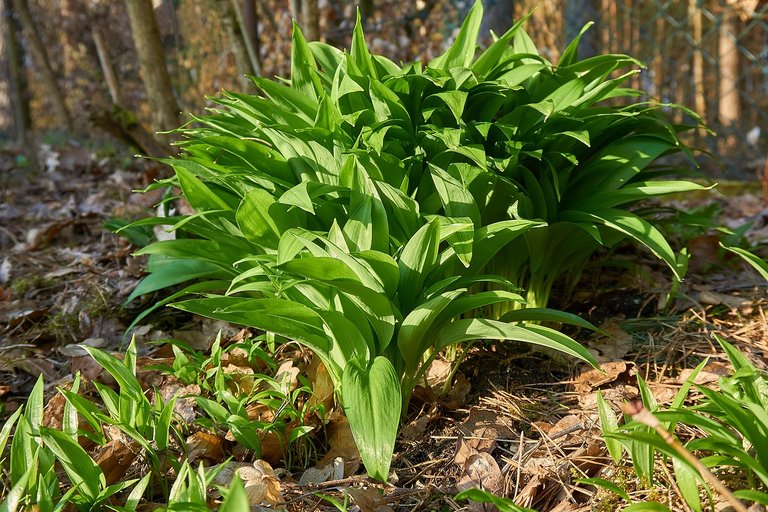Wild Leeks or "Ramps" (Allium tricoccum)

Greetings, everyone! With spring weather slowly setting in here in the Northern Hemisphere come the spring delicacies! Today I'm going to be talking about the wild onion-like plants known as ramps (short for ramsoms), wood leeks, or spring onions. Pictured is a ramp growing in my own garden! Luckily, it will give me a good gauge for when the ramps in the wild are ready.
Where do they grow?
Ramps grow in the eastern United States and Canada. Their natural habitat is woodland where there is some light. They are easy to spot since they can grow in large groups and their two elliptical leaves are some of the first greens that come up in the spring.

[Source][https://pixabay.com/photos/bear-s-garlic-allium-ursinum-3315975/]
What parts are edible?
Actually, the bulb and the leaves are edible. The leaves taste just as good as the bulb and they can both be eaten raw or cooked.
What to consider when harvesting
Ramps are an ephemeral slow growing plant whose life cycle lasts 7 years. Harvest time varies, but is usually from mid to late April or early May. Depending on the location, they can appear to grow in abundance, however they are a threatened species in Quebec and of special concern in Maine, Tennessee, and Rhode Island.
As a seed, they can remain dormant in the soil for up to 2 years. In the short photosynthetic phase, the leaves store compounds and nutrients before falling and withering away. When they decompose, the compounds pass to the bulb and this allows new leaves to grow next year. That is why it is important to only harvest one leaf per plant, but also so that the plant is able to go into bloom later in July. The bulb can be harvested after about 2 or 3 years of growth and should be dug out by hand, not with a shovel. Be sure the shake off any excess dirt where there may be seeds and only harvest in places where it grows abundantly. Do not harvest all of them; doing so will ensure that no new leeks will appear for the next several years in that location. It is important to harvest sustainably!
Medicinal Uses
Being one of the first spring edibles to emerge, ramps have long been used by people and tribes like the Cherokee as a spring tonic after the long winter or as a remedy for the common cold. The juice from the bulbs can be used to treat insect stings or it can be warmed for use to treat ear aches. Ramp decoction works as an emetic and also treats worms in children. Ramps are high in antioxidants and their sulphur compounds help to protect the linings of blood vessels. Be sure to make wild leek vinegar to preserve the vitamins and freshness for later use!
Conclusion
I hope you liked this post about the wild leek. I encourage you to go out and forage for some if you live in their natural range. Remember to be considerate and harvest this natural wonder sustainably so that you and others can benefit from this fleeting treat for years to come!
Thank you for visiting!
That's all, folks!
[Source][https://www.ediblewildfood.com/blog/2017/03/how-to-take-a-leek-in-the-woods/]
Cool, I'll keep an eye out for these on my next hunt. How big do the bulbs get?
They are rather small. It's takes about 50 to make a pound.
Well at least the leaves are edible too. I just have to make sure it isn't the deadly camas.
Oh what's that? I've never heard of that. Just crush a little bit of the leaf and it should have a strong onion aroma. That's a good, easy way to identify it.
Are these them? The smell/taste is very mild compared to a normal onion...
No, ramps only have 2 leaves
Yeah I figured, later I found a few that smelled/tasted more like onions. I suspect these things might have been some kind of wildflower lol. Still no morels out here in suburbia, too cold I guess.
I don't think we have that here. They seem to be delicate to grow but it's an interesting plant.
Yeah it only grows in North America. Glad you enjoyed it!